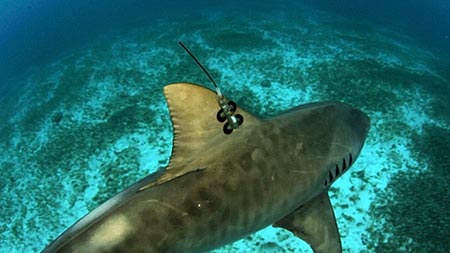Marine protected areas: a viable conservation approach for wide ranging species?
by Fiona Graham, RJD Intern
Marine protected areas (MPAs) are regions of the ocean that have been zoned off and designated a level of protection. Different levels of protection can be offered by these zones, for example a no take zone, where regulations in that area do not permit fishing of any kind. Another example is a research only area, where recreation and commercial activities are not allowed.
While MPAs are effective at employing ecosystem-based management as a conservation tool, these networks of protected zones must be carefully chosen. MPAs function best as a well-connected group of distinct patches (a spatial network), each working to supplement the benefits of another, rather than as independent zones. Therefore, strategic area placement and size is crucial for the best conservation outcome. MPAs operating as ecologically cohesive networks should perform a variety of functions, including interacting with and supporting the surrounding environment. They should also maintain the processes, functions and structures of the intended protected features across their natural range, and function synergistically as a whole, such that the individual protected sites are able to benefit from each other (Ardron et al. 2008).

Satellite tags can help scientists to determine how large of a marine protected area wide-ranging fish need
To properly evaluate an MPA system, it’s important to look at both the percentage of species’ habitat that is protected, and how connected the system is for that species (Sundblad et al. 2010). Assessing habitat protection and connectivity is generally performed on a species-specific basis, to determine the effectiveness of the MPA system at preserving that particular species. However, a number of species can be selected to attempt to represent the biodiversity of the ecosystem (Anadón et al. 2011, Caro et al. 1999).
While MPAs are a popular conservation management tool, their effectiveness for large sharks is still not fully known. It has been predicted that highly mobile fish will not benefit from the protection of an MPA (e.g. DeMartini 1993, Walters et al. 1999). Other studies, however have shown that MPAs may actually provide benefits for highly mobile species with wide home ranges such as many shark species (Knip et al. 2012, Claudet et al. 2010). Acoustic transmitters were used to show that some species of tropical coastal sharks exhibited long term use of the protected areas, and that different species and life stages can benefit from the protection of these zones (Knip et al. 2012).
It is particularly important to determine the effectiveness of MPAs for these populations of apex predatory species. Their populations have been declining rapidly worldwide (Baum et al. 2003) and so management strategies to mitigate these trends are essential. These declines are due primarily to overexploitation by the commercial fishing industry, driven by demand for shark fin and incidental bycatch by other fisheries (Clarke et al 2006). Life history characteristics, such as long lifespan, slow growth, and low fecundity, make shark populations particularly vulnerable to overexploitation and fishing pressure. In addition to these major threats, other human influences also take their toll on shark populations, such as recreational fishing, pollution and habitat destruction.
While the benefits of implementing clear protected zones are more obvious for species that live sedentary lifestyles, the proportion of habitat protection that they offer to wide-ranging species is less clear. It is important to note also that MPA use may vary within species, within individuals in the same species, and seasonally. More information and research on the movement patterns and habitat use of such species must be obtained though tracking studies to analyze the conservation effectiveness of a particular MPA and tailor its design for maximum success.
REFERENCES
Anadón JD , D’Agrosa C , Gondor A , Gerber LR (2011) Quantifying the Spatial Ecology of Wide-Ranging Marine Species in the Gulf of California: Implications for Marine Conservation Planning. PLoS ONE 6(12): e28400. doi:10.1371/journal.pone.0028400
Ardron JA (2008) Three initial OSPAR tests of ecological coherence: heuristics in a data-limited situation. Ices Journal of Marine Science 65: 1527-1533.
Baum JK, Myers RA, Kehler DG, Worm B, Harley SJ, Doherty P (2003) Collapse and conservation of shark populations in the northwest Atlantic. Science 299: 389-392.
Caro TM, O’Doherty G (1999) On the use of surrogate species in conservation biology. Conservation Biology 13: 805-814.
Claudet, J., et al. 2010. Marine reserves: fish life history and ecological traits matter.
Ecological Applications 20:830–839.
Clarke, S., Magnussen, J.E., Abercrombie, D.L., McAllister, M. & Shivji, M. (2006).
Identification of shark species composition and proportion in the Hong Kong
shark fin market based on molecular genetics and trade records. Conserv.
Biol., 20, 201–211.
DeMartini, E. E. (1993) Modeling the potential of fishery reserves for managing
Pacific coral reef fishes. Fisheries Bulletin 91:414–427.
Knip DM, Heupel CA, Simpfendorfer CA (2012) Evaluating marine protected areas
for the conservation of tropical coastal sharks. Biological Conservation 148:
200.
Sundblad G, Bergstrom U, Sandstrom A (2011) Ecological coherence of marine protected area networks: a spatial assessment using species distribution models. Journal of Applied Ecology 48: 112-120.
Walters, C., D. Pauly, and V. Christensen. 1999. Ecospace: prediction of mesoscale
spatial patterns in trophic relationships of exploited ecosystems, with
emphasis on the impacts of marine protected areas. Ecosystems 2:539–554.




Leave a Reply
Want to join the discussion?Feel free to contribute!